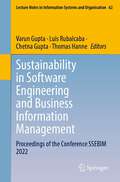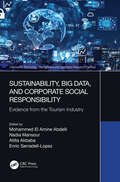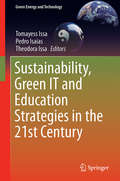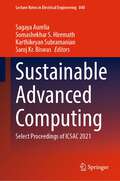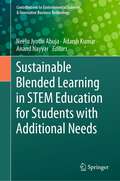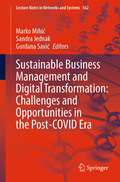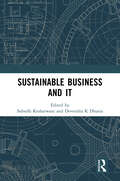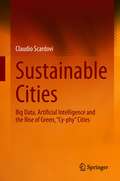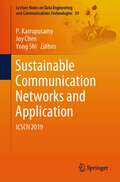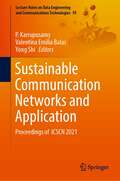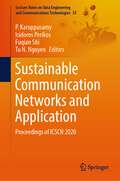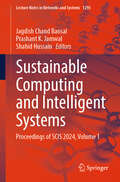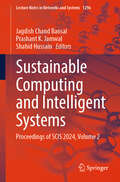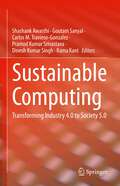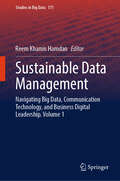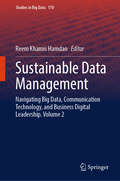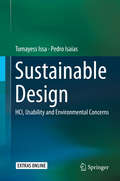- Table View
- List View
Sustainability in Software Engineering and Business Information Management: Proceedings of the Conference SSEBIM 2022 (Lecture Notes in Information Systems and Organisation #62)
by Thomas Hanne Varun Gupta Chetna Gupta Luis RubalcabaThe proceedings volume presents selected papers from the International Conference on Sustainability in Software Engineering & Business Information Management: Innovation & Applications (SSEBIM 2022) held in Olten, Switzerland from September 23-24, 2022. It includes research related to sustainability from both a business and technical point of view. From a business perspective, it not only addresses how to make the business operations more sustainable, but also considers factors such as human values, ethics, environment and responsibility of the businesses. From the technical perspective of software development companies, it focuses on sustainability in software engineering ranging from practices, tools, techniques and methods. The contributions reflect how software engineering teams exhibited pro-activeness in their approaches to lead to sustainable development of the software that is of highest quality and reliability.It is intended for a broad audience, including students, researchers and practitioners who work in software engineering and business information management fields.
Sustainability in the Gig Economy: Perspectives, Challenges and Opportunities in Industry 4.0
by Ashish Gupta Badri Narayanan Gopalakrishnan Tavishi TewaryThis book provides a comprehensive and contemporary source of reference for the gig economy for sustainable businesses with a focus on Industry 4.0. It covers the theoretical and practical implications of the rise of an alternative system in the era of technology-driven business entities; and explains the emergence of the gig economy as a crucial factor in devising approaches that will help in ensuring better decision making.As the COVID-19 pandemic rages on, investors and corporations are attempting to overcome the turbulence in financial markets over the past few months. Governments and economists are scrambling to mitigate the impacts of lockdowns. Many businesses have transferred to a remote working system, and the critical challenge remains to make this form of work and business productive, efficient, and sustainable. Against this backdrop, the book provides an overview of the gig economy from varied perspective such as general business and economics; ethics, governance, and legal issues; diffusion of IT in the workplace; sustainability; future of workforce and workplaces during and post-pandemic scenarios. This edited volume also highlights several challenges and opportunities for managing the diverse workforce in the prevailing situation which has no precedence.With its discussions on the impact of the gig economy on the business world, the book carries appeal for scholars in the business, human resource professionals, industry practitioners, corporates, and policy advocates interested in learning about evolution, automation, marketing, and sustainability in the gig economy.
Sustainability of Water Resources: Impacts and Management (Water Science and Technology Library #116)
by Vijay P. Singh Ashish Pandey R. D. Singh Basant Yadav Mohit Prakash MohantyThis book covers a wide spectrum of water resources management, including water supply and demand, operation and maintenance of water distribution systems, water quality assessment, impacts of climate change on hydrological extremes, and water governance. Rapid urbanization, industrialization, and population growth are the major factors contributing to a significant rise in water demands across all the sectors in India. Although the Indian Summer Monsoon Rainfall contributes primarily to the available surface and groundwater resources, recurrent non-uniform/erratic rainfall events have resulted in widespread water scarcity. On many occasions, extreme meteorological conditions trigger the severity of water-related disasters such as floods and droughts. The untreated wastewater from domestic and industrial sources discharged through un-engineered means, adds to the issue as it ends up polluting the surface and groundwater resources.
Sustainability, Big Data, and Corporate Social Responsibility: Evidence from the Tourism Industry (Information Technology, Management and Operations Research Practices)
by Abdelli, Mohammed El AmineThis book aims to provide theoretical and empirical frameworks and highlights the challenges and solutions with using Big Data for Corporate Social Responsibility (CSR) and Sustainability in the field of digital transformation and tourism. Sustainability, Big Data, and Corporate Social Responsibility: Evidence from the Tourism Industry offers a theoretical and empirical framework in the field of digital transformation and applies it to the tourism sector. It discusses Big Data used with CSR and sustainability for the improvement of innovation and highlights the challenges and prospects. It presents a modern insight and approach for use by decision-makers as an application to solve various problems and explores how data collection can shed light on consumer behavior making it possible to account for existing situations and plan for the future. This book is intended to provide a modern insight for researcher, students, professionals, and decision-makers on the application of Big Data to improve CSR and sustainability in the tourism sector.
Sustainability, Green IT and Education Strategies in the Twenty-first Century
by Pedro Isaias Tomayess Issa Theodora IssaThis work presents and discusses the latest approaches and strategies for implementing Sustainability and Green IT into higher education and business environments. Following the global financial crisis in 2007/2008, businesses began to struggle coping with the increased IT/IS cost and their environmental footprint. As a consequence, action by universities to incorporate sustainability and ‘Green IT’ as parts of their teaching and learning materials, acknowledging their importance for global and local businesses, is being increasingly implemented. The book addresses the cooperation and coordination between academics and practitioners needed in order to achieve the changes required to obtain sustainability.Intended for researchers, lecturers and post-graduate students, as well as professionals in the Information Society and ICT and education sectors, and policy makers.
Sustainability: Cases and Studies in Using Operations Research and Management Science Methods (International Series in Operations Research & Management Science #333)
by Fausto Pedro García Márquez Benjamin LevThis book provides relevant theoretical frameworks and the latest empirical research findings in Operations Research (OR) and Management Science (MS) as applied to sustainability. Its goal is to identify and describe ways in which OR and MS have been applied to and influenced the development of sustainability. Many of the issues we face today stem from the interconnectivity of the economy, society, and the environment, and from how both the economy and society are affecting the environment. In response, there have been a range of local and global efforts to advance society without harming the natural environment. The book showcases how OR/MS can help to address these issues, specifically with regard to renewable energy, smart industry, smart cities, transportation, smart homes and devices, etc. This book is intended for professionals in the fields of energy, engineering, information science, mathematics and economics, and for researchers who wish to develop new skills in connection with sustainability, or whose work involves sustainability.
Sustainable Advanced Computing: Select Proceedings of ICSAC 2021 (Lecture Notes in Electrical Engineering #840)
by Somashekhar S. Hiremath Sagaya Aurelia Karthikeyan Subramanian Saroj Kr. BiswasThis volume presents select proceedings of the International Conference on Sustainable Advanced Computing (ICSAC – 2021). It covers the latest research on a wide range of topics spanning theory, systems, applications, and case studies in advanced computing. Topics covered are machine intelligence, expert systems, robotics, natural language processing, cognitive science, quantum computing, deep learning, pattern recognition, human-computer interface, biometrics, graph theory, etc. The volume focuses on the novel research findings and innovations of various researchers. In addition, the book will be a promising solution for new generation-based sustainable, intelligent systems that are machine and human-centered with modern models and appropriate amalgamations of collaborative practices with a general objective of better research in all aspects of sustainable advanced computing.
Sustainable Approaches in Textiles and Fashion: Consumerism, Global Textiles and Supply Chain (Sustainable Textiles: Production, Processing, Manufacturing & Chemistry)
by Subramanian Senthilkannan MuthuThis second volume in this set of books discusses various sustainable approaches in textiles and the fashion sector with a focus on consumerism and the supply chain. Sustainability is one of the important aspects in today’s industrial context, and is no exception to textiles and fashion. Sustainability and strict adherence to the principles of sustainability has become as one of the essential needs again for any industrial sector including textiles and fashion. There are countless measures in terms of various approaches to make the textiles and fashion sector sustainable. These measures, but not limited to, ranging from innovating and implementing new fibres and raw materials, introducing innovative manufacturing methods, chemicals, processes to focus on all the possible stages of a textile product’s life cycle from cradle to grave. These approaches include making the textiles and fashion sector circular and also development of new products from sustainable raw materials/processes or combination of both.
Sustainable Blended Learning in STEM Education for Students with Additional Needs (Contributions to Environmental Sciences & Innovative Business Technology)
by Anand Nayyar Adarsh Kumar Neelu Jyothi AhujaThis book comprehensively covers sustainable blended learning approach in each of the STEM (science, technology, engineering and mathematics) disciplines. The book also includes the compilation of detailed concepts of blended learning ranging from definition, need, features, models, advantages and disadvantages and comparisons with traditional face-to-face learning. Sustainable blended learning in K-12 education has an immense role as foundation to learning for students in their early education. Fostering creativity and inculcating problem solving and critical thinking skills are the integral aspect of STEM education, which encourages students to pursue them to for their future careers. This book presents recent practices taken by experts at various levels to promote education in STEM. Furthermore, impact over teacher–student relationships is analyzed. Lastly, sustainable frameworks, strategies and implementation to incorporate students with additional needs are explored.
Sustainable Business Management and Digital Transformation: Challenges and Opportunities in the Post-COVID Era (Lecture Notes in Networks and Systems #562)
by Marko Mihić Sandra Jednak Gordana SavićThis book covers high-quality peer-reviewed research papers presented at the 18th International Symposium of Organizational Sciences (SymOrg 2022) held in Belgrade, Serbia, from 11 to 14 June 2022. The aim of the book is providing stimulative framework for readers to explore viable alternatives and indicate implications for the post-pandemic world. Researchers from academia and industry present their original work focusing on different aspects of sustainable management and digital transformation including blockchain technology, business analytics, e-business, innovation, digital operations and logistics management, financial industry, public administration, lean business systems, digital transformation projects, human resources, marketing and communication, and quality and standardization. The chapters could be useful for industry experts, research institutions, universities, and all others who share a common interest in contemporary organizational sciences.
Sustainable Business and IT
by Subodh Kesharwani Devendra K. DhusiaAs Information Technology continues to evolve as a key strategic enabler, many establishments feel the need to think more holistically about how IT can support corporate sustainability efforts. This book aims to recognize these efforts and best practices in numerous business settings. Sustainability is expensive, and requires collaboration between many different areas of the business. The solution to the growing burden of carbon emission lies within the technology innovation as continued advancements in processes make businesses lean and smart. The multidisciplinary approach the book uses will be appreciated by students, academics and researchers in Information Technology, Management, Corporate, and Sustainability Champions. Print edition not for sale in South Asia (India, Sri Lanka, Nepal, Bangladesh, Pakistan and Bhutan)
Sustainable Cities: Big Data, Artificial Intelligence and the Rise of Green, “Cy-phy” Cities
by Claudio ScardoviGlobal cities are facing an almost unprecedented challenge of change. As they re-emerge from the Covid 19 pandemic and get ready to face climate change and other, potentially existential threats, they need to look for new ways to support wealth and wellbeing creation – leveraging Big Data and AI and suing them into their physical reality and to become greener, more inclusive and resilient, hence sustainable.This book describes how new digital technologies could be used to design digital and physical twins of cities that are able to feed into each other to optimize their working and ability to create new wealth and wellbeing. The book also describes how to increase cities’ social and economic resilience during crisis time and addressing their almost fatal weaknesses – as it became all too obvious during the recent COVID 19 crisis. Also, the book presents a framework for a critical discussion of the concept of “smart-city”, suggesting its development into a “cyber” and “meta” one – meaning, not only digital systems can allow physical ones (e.g. cities, citizens, households and companies) to become “smarter”, but also the vice versa is true, as off line data and real life behaviours can support the optimization and development of virtual brains as a sum of big data and artificial intelligence apps all sitting “over the cloud”. An analysis of the fundamental dynamics of this emerging “info-telligence” economy, and of the potential role of big digital players like Amazon, Google and Facebook is then paving the way to discuss a few strategic forays on how traditional sectors such as financial services, real estate, TMT or health could also evolve, leveraging Big Data and AI in a cyber-physical integrated setting. Finally, a number of thought provoking use cases that could be designed around individuals, and to improve the success and the resilience of households and companies living and working in urban areas are discussed, as an example of one of the most exciting future markets to come: the one of global, sustainable cities
Sustainable Communication Networks and Application: ICSCN 2019 (Lecture Notes on Data Engineering and Communications Technologies #39)
by Yong Shi P. Karrupusamy Joy ChenThis book presents state-of-the-art theories and technologies and discusses developments in the two major fields: engineering and sustainable computing. In this modern era of information and communication technologies [ICT], there is a growing need for new sustainable and energy-efficient communication and networking technologies. The book highlights significant current and potential international research relating to theoretical and practical methods toward developing sustainable communication and networking technologies. In particular, it focuses on emerging technologies such as wireless communications, mobile networks, Internet of things [IoT], sustainability, and edge network models. The contributions cover a number of key research issues in software-defined networks, blockchain technologies, big data, edge/fog computing, computer vision, sentiment analysis, cryptography, energy-efficient systems, and cognitive platforms.
Sustainable Communication Networks and Application: Proceedings of ICSCN 2021 (Lecture Notes on Data Engineering and Communications Technologies #93)
by Yong Shi Valentina Emilia Balas P. KarrupusamyThis book includes high-quality research papers presented at 3rd International Conference on Sustainable Communication Networks and Applications (ICSCN 2021), which is held at Surya Engineering College (SEC), Erode, India, during 29–30 July 2021. This book includes novel and state-of-the-art research discussions that articulate and report all research aspects, including theoretical and experimental prototypes and applications that incorporate sustainability into emerging applications. The book discusses and articulates emerging challenges in significantly reducing the energy consumption of communication systems and also explains development of a sustainable and energy-efficient mobile and wireless communication network. It includes best selected high-quality conference papers in different fields such as Internet of Things, cloud computing, data mining, artificial intelligence, machine learning, autonomous systems, deep learning, neural networks, renewable energy sources, sustainable wireless communication networks, QoS, network sustainability, and many other related areas.
Sustainable Communication Networks and Application: Proceedings of ICSCN 2020 (Lecture Notes on Data Engineering and Communications Technologies #55)
by Fuqian Shi Isidoros Perikos P. Karuppusamy Tu N. NguyenThis book includes novel and state-of-the-art research discussions that articulate and report all research aspects, including theoretical and experimental prototypes and applications that incorporate sustainability into emerging applications. In recent years, sustainability and information and communication technologies (ICT) are highly intertwined, where sustainability resources and its management has attracted various researchers, stakeholders, and industrialists. The energy-efficient communication technologies have revolutionized the various smart applications like smart cities, healthcare, entertainment, and business. The book discusses and articulates emerging challenges in significantly reducing the energy consumption of communication systems and also explains development of a sustainable and energy-efficient mobile and wireless communication network. It includes best selected high-quality conference papers in different fields such as internet of things, cloud computing, data mining, artificial intelligence, machine learning, autonomous systems, deep learning, neural networks, renewable energy sources, sustainable wireless communication networks, QoS, network sustainability, and many other related areas.
Sustainable Community Development in Ghana (Routledge Studies in African Development)
by John Kwame Boateng Isaac Kofi Biney Paul Gary NixonThis book explores sustainable community development in Ghana post-COVID-19, highlighting examples of how individuals facing extreme challenges have adapted to their changing circumstances.Through the voices of African researchers, it explores the different responses that local, subnational, and national stakeholders and communities initiated to preserve the gains made in achieving the Sustainable Development Goals in Ghana during the global pandemic. This collection considers how policy makers are tackling the pressing issues of sustainability, climate change and its effects on Africa and Ghana in particular, and multi-stakeholder policy responses to building communities in a post-COVID-19 world. The case studies show how communities are interacting to ensure sustainable community development and learning in the Global South, and the role that education and learning, both formal and informal, play in strengthening livelihoods, choices, and opportunities in African communities.An assessment of multi-stakeholder policy responses to building communities in Ghana, this book will be of interest to scholars and students in the field of Education, Education Management, Sociology, Economics, and African Studies. It will also be of interest to policy makers and practitioners engaged in community development programmes and activities and the development of associated policies.
Sustainable Computing and Intelligent Systems: Proceedings of SCIS 2024, Volume 1 (Lecture Notes in Networks and Systems #1295)
by Jagdish Chand Bansal Shahid Hussain Prashant K. JamwalThis book presents selected papers from International Conference on Sustainable Computing and Intelligent Systems (SCIS 2024), held on 9–10 September 2024, in University of Canberra, Bruce, Australia. The topics covered in the book are green computing, renewable energy integration, sustainable urban computing, IoT and sustainability, sustainable IoT applications, data analytics for sustainability, internet of things, information security, embedded systems, real-time systems, cloud computing, big data analysis, quantum computing, automation systems, intelligent IoT eHealth, bio-inspired intelligence, brain modeling and simulation, cognitive systems, cyber-physical systems, data analytics, data/web mining, data science, hybrid systems and intelligence for security.
Sustainable Computing and Intelligent Systems: Proceedings of SCIS 2024, Volume 2 (Lecture Notes in Networks and Systems #1296)
by Jagdish Chand Bansal Shahid Hussain Prashant K. JamwalThis book presents selected papers from International Conference on Sustainable Computing and Intelligent Systems (SCIS 2024), held on 9–10 September 2024, in University of Canberra, Bruce, Australia. The topics covered in the book are green computing, renewable energy integration, sustainable urban computing, IoT and sustainability, sustainable IoT applications, data analytics for sustainability, internet of things, information security, embedded systems, real-time systems, cloud computing, big data analysis, quantum computing, automation systems, intelligent IoT eHealth, bio-inspired intelligence, brain modeling and simulation, cognitive systems, cyber-physical systems, data analytics, data/web mining, data science, hybrid systems and intelligence for security.
Sustainable Computing: Transforming Industry 4.0 to Society 5.0
by Dinesh Kumar Singh Carlos M. Travieso-Gonzalez Goutam Sanyal Shashank Awasthi Pramod Kumar Srivastava Rama KantThis book presents recent advancements in Industry 4.0 and addresses how these can be useful in achieving sustainable solutions in Society 5.0. The book also serves as a reference for developing sustainable engineering solutions to various socio-economic and techno-commercial issues. The book is meticulously structured into two sections: Section I sheds light on fundamentals, nitty-gritties, and principles of technological innovations and advancement in artificial intelligence, cloud computing, industrial Internet of Things (IIOT), and Society 5.0, whereas Section II covers viable engineering solutions developments for revamping Industry 4.0 to Society 5.0. Overall, the authors aim to show how technological advancements can be used to address social issues and improve society.
Sustainable Data Management: Navigating Big Data, Communication Technology, and Business Digital Leadership. Volume 1 (Studies in Big Data #171)
by Reem Khamis HamdanThis book dives into a new world of data and technology with the groundbreaking Sustainable Data Management, immerses readers in the realm of big data, and explores how digital technology can revolutionize business leadership. Discover how this book can guide readers through the deep waters of sustainable and efficient data management.
Sustainable Data Management: Navigating Big Data, Communication Technology, and Business Digital Leadership. Volume 2 (Studies in Big Data #170)
by Reem Khamis HamdanThis book dives deeper into the dynamic world of data and technology with the Sustainable Data Management and explores advanced strategies and innovative approaches to harnessing big data, leveraging communication technology, and mastering digital leadership in today's evolving business landscape. Uncover insights and techniques that propel readers organization towards sustainable success in the digital age.
Sustainable Design
by Pedro Isaias Tomayess IssaThis book is concerned with the importance of Human Computer Interaction (HCI), Usability, user participants, and Sustainability in the Information Communication Technology (ICT) industry throughout the world. ICT has become a crucial instrument for communication, entertainment, commerce and research and this increased usage is presenting new environmental and sustainability issues as we try and meet the ever growing needs of both businesses and individuals. Sustainability must become central to the design of new technologies to make a concerted effort to tackle the environmental concerns we face now and for the future. Development frameworks, tools and models are used and explored and the New Participative Methodology for Sustainable Design (NPMSD) is introduced as a way of identifying key factors needed in developing more sustainable systems including new smart technology and portable devices. It is hoped additional research will be carried out in the future to assess these sustainable design steps using larger, more diverse countries with developed and developing economies to further refine such methods. Sustainable Design will be an invaluable resource for students and researchers, designers and business managers who are interested in the human-centred, environmental concerns of sustainable technologies
Sustainable Design and Manufacturing 2018: Proceedings of the 5th International Conference on Sustainable Design and Manufacturing (KES-SDM-18) (Smart Innovation, Systems and Technologies #130)
by Robert J. Howlett Rossi Setchi Ljubo Vlacic Dzung DaoThis book gathers papers presented at the 5th International Conference on Sustainable Design and Manufacturing (SDM-18), held in Gold Coast, Australia in June 2018. The conference covered a wide range of topics, including: sustainable product design and service innovation, sustainable processes and technology for the manufacturing of sustainable products, sustainable manufacturing systems and enterprises, decision support for sustainability, and the study of the societal impact of sustainability including research on the circular economy. The corresponding application areas are wide and varied. The aim of cutting-edge research into sustainable design and manufacturing is to enable the manufacturing industry to grow by adopting more advanced technologies, and at the same time improve its sustainability by reducing its environmental impact. With these goals in mind, the book provides an excellent overview of the latest research and development in the area of Sustainable Design and Manufacturing.
Sustainable Design and Manufacturing 2019: Proceedings of the 6th International Conference on Sustainable Design and Manufacturing (KES-SDM 19) (Smart Innovation, Systems and Technologies #155)
by Robert J. Howlett Rossi Setchi Peter Ball Luisa Huaccho HuatucoThis volume consists of 52 peer-reviewed papers, presented at the International Conference on Sustainable Design and Manufacturing (SDM-19) held in Budapest, Hungary in July 2019. Leading-edge research into sustainable design and manufacturing aims to enable the manufacturing industry to grow by adopting more advanced technologies, and at the same time improve its sustainability by reducing its environmental impact. The topic includes the sustainable design of products and services; the sustainable manufacturing of all products; energy efficiency in manufacturing; innovation for eco-design; circular economy; industry 4.0; industrial metabolism; automotive and transportation systems. Application areas are wide and varied. The book will provide an excellent overview of the latest developments in the Sustainable Design and Manufacturing Area.
Sustainable Design: HCI, Usability and Environmental Concerns
by Pedro Isaias Tomayess IssaThis book is concerned with the importance of Human Computer Interaction (HCI), Usability, user participants, and Sustainability in the Information Communication Technology (ICT) industry throughout the world. ICTs have become a crucial instrument for communication, entertainment, commerce and research and this increased usage is presenting new environmental and sustainability issues as we try and meet the ever-growing needs of both businesses and individuals. Sustainability and sustainable design must become central to the design of new technologies to make a concerted effort to tackle the environmental concerns we face now and in the future. Development frameworks, tools and models are used and explored, and the New Participative Methodology for Sustainable Design (NPMSD) is introduced as a way of identifying key factors needed in developing more sustainable systems including new smart technology and portable devices.In this book, the sustainable step in the design stage is evaluated and assessed by 11 countries: namely, Australia, Brazil, China, Germany, India, Norway, Singapore, South Korea, Sweden, UK, and USA. The new results are generated confirming that sustainable design awareness should be considered by designers, and users to minimize and reduce the carbon emissions, raw materials usage, and global warming, since these problems should be tackled soon, otherwise, it will be too late to solve it. Further research is needed in the future to implement and assess the sustainable design step with large IT companies to ensure compliance with environmental standards and rules for sustainable systems.Sustainable Design is an invaluable resource for students and researchers, designers and business managers who are interested in the human-centered, environmental concerns of sustainable technologies.
